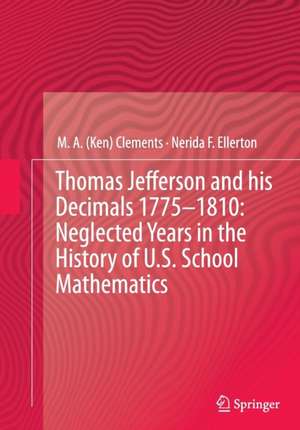Thomas Jefferson and his Decimals 1775–1810: Neglected Years in the History of U.S. School Mathematics
Autor M.A. (Ken) Clements, Nerida F. Ellertonen Limba Engleză Paperback – 23 aug 2016
The book shows, by analyzing a large set of arithmetic textbooks and an even larger set of handwritten cyphering books, that although most eighteenth- and nineteenth-century authors of arithmetic textbooks included sections on vulgar and decimal fractions, most school students who prepared cyphering books did not study either vulgar or decimal fractions. In other words, author-intended school arithmetic curricula were not matched by teacher-implemented school arithmetic curricula. Amazingly, that state of affairs continued even after the U.S. Mint began minting dollars, cents and dimes in the 1790s. In U.S. schools between 1775 and 1810 it was often the case that Federal money was studied but decimal fractions were not. That gradually changed during the first century of the formal existence of the United States of America. By contrast, Chapter 6 reports a comparative analysis of data showing that in Great Britain only a minority of eighteenth- and nineteenth-century school students studied decimal fractions. Clements and Ellerton argue that Jefferson’s success in establishing a system of decimalized Federal money had educationally significant effects on implemented school arithmetic curricula in the United States of America.
The lens through which Clements and Ellerton have analyzed their large data sets has been the lag-time theoretical position which they have developed. That theory posits that the time between when an important mathematical “discovery” is made (or a concept is“created”) and when that discovery (or concept) becomes an important part of school mathematics is dependent on mathematical, social, political and economic factors. Thus, lag time varies from region to region, and from nation to nation.
Clements and Ellerton are the first to identify the years after 1775 as the dawn of a new day in U.S. school mathematics—traditionally, historians have argued that nothing in U.S. school mathematics was worthy of serious study until the 1820s. This book emphasizes the importance of the acceptance of decimal currency so far as school mathematics is concerned. It also draws attention to the consequences for school mathematics of the conscious decision of the U.S. Congress not to proceed with Thomas Jefferson’s grand scheme for a system of decimalized weights and measures.
| Toate formatele și edițiile | Preț | Express |
|---|---|---|
| Paperback (1) | 387.38 lei 6-8 săpt. | |
| Springer International Publishing – 23 aug 2016 | 387.38 lei 6-8 săpt. | |
| Hardback (1) | 396.40 lei 6-8 săpt. | |
| Springer International Publishing – 3 dec 2014 | 396.40 lei 6-8 săpt. |
Preț: 387.38 lei
Nou
Puncte Express: 581
Preț estimativ în valută:
74.14€ • 76.59$ • 61.70£
74.14€ • 76.59$ • 61.70£
Carte tipărită la comandă
Livrare economică 25 martie-08 aprilie
Preluare comenzi: 021 569.72.76
Specificații
ISBN-13: 9783319347103
ISBN-10: 3319347101
Pagini: 224
Ilustrații: XX, 204 p. 45 illus., 38 illus. in color.
Dimensiuni: 178 x 254 x 12 mm
Greutate: 0.4 kg
Ediția:Softcover reprint of the original 1st ed. 2015
Editura: Springer International Publishing
Colecția Springer
Locul publicării:Cham, Switzerland
ISBN-10: 3319347101
Pagini: 224
Ilustrații: XX, 204 p. 45 illus., 38 illus. in color.
Dimensiuni: 178 x 254 x 12 mm
Greutate: 0.4 kg
Ediția:Softcover reprint of the original 1st ed. 2015
Editura: Springer International Publishing
Colecția Springer
Locul publicării:Cham, Switzerland
Cuprins
Early Moves Toward Metrication in Europe.- Measurement Chaos in North America, 1780–1980.- Opportunity Lost: Big Money Successfully Thwarts Thomas Jefferson’s Push for Metrication 1776–1793.- Muddling Along: Opposition to Moves for Metrication, 1793–1920.- David Eugene Smith’s Involvement in the Metrication Issue, 1920–1935.- The Decision for Metrication, 1970.- Reaganomics, Big Money, and the Crushing of the Metric Dream, 1970-1980.- Why has the United States Never Achieved Metrication?.
Notă biografică
M. A. (“Ken”) Clements is Professor in the Department of Mathematics at Illinois State University. After teaching in schools for 10 years, he taught in three Australian universities (Monash, Deakin, and Newcastle), and at Universiti Brunei Darussalam (1997–2004). He has served as a consultant in India, Malaysia, PNG, South Africa, Thailand and Vietnam, and has been an editor for the three international handbooks on mathematics education (1996, 2003, 2012). He has written or edited 25 books and has authored many peer-reviewed articles. In 1996 he co-authored, with Nerida Ellerton, a UNESCO book on mathematics education research. He is honorary life member of both the Mathematics Education Research Group of Australasia (MERGA) and the Mathematical Association of Victoria (MAV).
Textul de pe ultima copertă
This well-illustrated book, by two established historians of school mathematics, documents Thomas Jefferson’s quest, after 1775, to introduce a form of decimal currency to the fledgling United States of America. The book describes a remarkable study showing how the United States’ decision to adopt a fully decimalized, carefully conceived national currency ultimately had a profound effect on U.S. school mathematics curricula.
The book shows, by analyzing a large set of arithmetic textbooks and an even larger set of handwritten cyphering books, that although most eighteenth- and nineteenth-century authors of arithmetic textbooks included sections on vulgar and decimal fractions, most school students who prepared cyphering books did not study either vulgar or decimal fractions. In other words, author-intended school arithmetic curricula were not matched by teacher-implemented school arithmetic curricula. Amazingly, that state of affairs continued even after the U.S. Mint began minting dollars, cents and dimes in the 1790s. In U.S. schools between 1775 and 1810 it was often the case that Federal money was studied but decimal fractions were not. That gradually changed during the first century of the formal existence of the United States of America. By contrast, Chapter 6 reports a comparative analysis of data showing that in Great Britain only a minority of eighteenth- and nineteenth-century school students studied decimal fractions. Clements and Ellerton argue that Jefferson’s success in establishing a system of decimalized Federal money had educationally significant effects on implemented school arithmetic curricula in the United States of America.
The lens through which Clements and Ellerton have analyzed their large data sets has been the lag-time theoretical position which they have developed. That theory posits that the time between when an important mathematical “discovery” is made (or a concept is“created”) and when that discovery (or concept) becomes an important part of school mathematics is dependent on mathematical, social, political and economic factors. Thus, lag time varies from region to region, and from nation to nation.
Clements and Ellerton are the first to identify the years after 1775 as the dawn of a new day in U.S. school mathematics—traditionally, historians have argued that nothing in U.S. school mathematics was worthy of serious study until the 1820s. This book emphasizes the importance of the acceptance of decimal currency so far as school mathematics is concerned. It also draws attention to the consequences for school mathematics of the conscious decision of the U.S. Congress not to proceed with Thomas Jefferson’s grand scheme for a system of decimalized weights and measures.
The book shows, by analyzing a large set of arithmetic textbooks and an even larger set of handwritten cyphering books, that although most eighteenth- and nineteenth-century authors of arithmetic textbooks included sections on vulgar and decimal fractions, most school students who prepared cyphering books did not study either vulgar or decimal fractions. In other words, author-intended school arithmetic curricula were not matched by teacher-implemented school arithmetic curricula. Amazingly, that state of affairs continued even after the U.S. Mint began minting dollars, cents and dimes in the 1790s. In U.S. schools between 1775 and 1810 it was often the case that Federal money was studied but decimal fractions were not. That gradually changed during the first century of the formal existence of the United States of America. By contrast, Chapter 6 reports a comparative analysis of data showing that in Great Britain only a minority of eighteenth- and nineteenth-century school students studied decimal fractions. Clements and Ellerton argue that Jefferson’s success in establishing a system of decimalized Federal money had educationally significant effects on implemented school arithmetic curricula in the United States of America.
The lens through which Clements and Ellerton have analyzed their large data sets has been the lag-time theoretical position which they have developed. That theory posits that the time between when an important mathematical “discovery” is made (or a concept is“created”) and when that discovery (or concept) becomes an important part of school mathematics is dependent on mathematical, social, political and economic factors. Thus, lag time varies from region to region, and from nation to nation.
Clements and Ellerton are the first to identify the years after 1775 as the dawn of a new day in U.S. school mathematics—traditionally, historians have argued that nothing in U.S. school mathematics was worthy of serious study until the 1820s. This book emphasizes the importance of the acceptance of decimal currency so far as school mathematics is concerned. It also draws attention to the consequences for school mathematics of the conscious decision of the U.S. Congress not to proceed with Thomas Jefferson’s grand scheme for a system of decimalized weights and measures.
Caracteristici
Extensive use of primary sources to fully detail the issue of metrication Synthesizes 400 years of historical data Analyzes the implications of non-metrication for mathematics educators and the field of mathematics education





